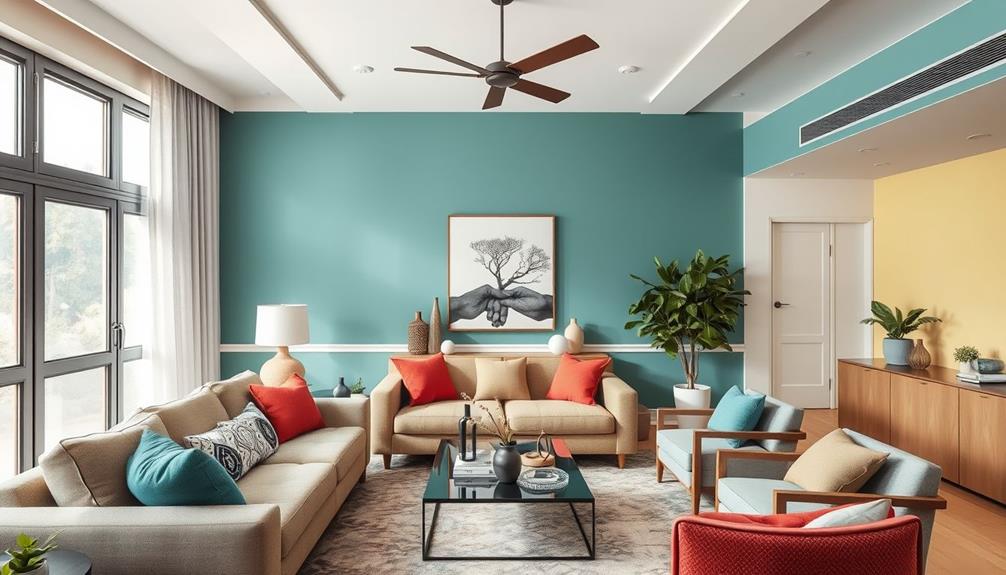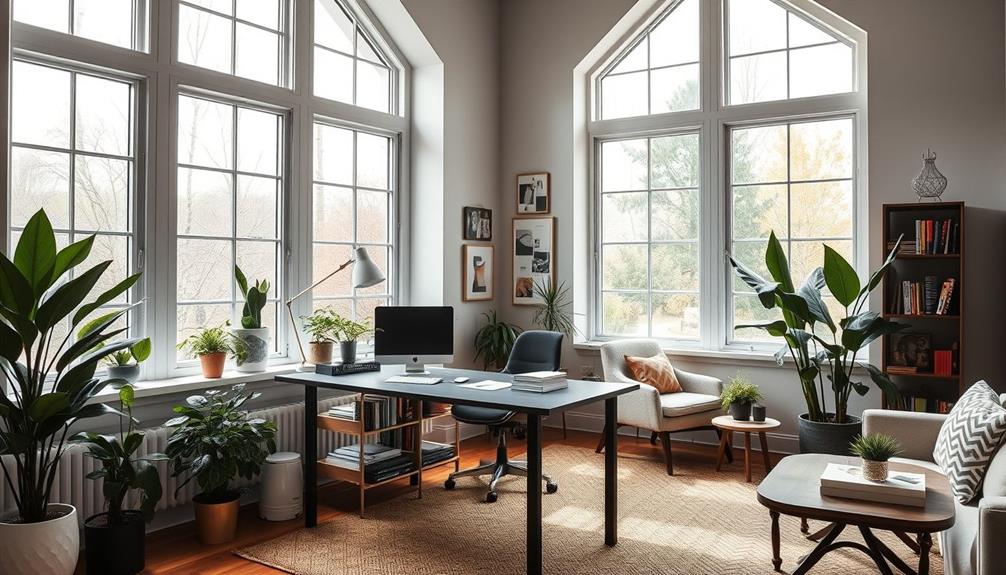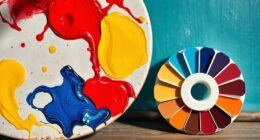Using Midjourney for interior design is easy and exciting. Start by creating a Discord account, then join the Midjourney server to begin. Use the /imagine command with detailed prompts, describing colors, styles, and furniture. You'll see unique images generated quickly, allowing you to explore different design concepts. Refine your outputs by upscaling or creating variations. You can even make mood boards for your projects. While there are some limitations to keep in mind, you'll discover plenty of creative possibilities. Stick around to uncover useful tips on maximizing your Midjourney experience for interior design projects.
Key Takeaways
- Start by creating a Discord account and joining the Midjourney server to access the image generation tools.
- Use the /imagine command with detailed prompts about colors, styles, and furniture to generate unique interior design concepts.
- Experiment with different prompt structures and refine them based on initial outputs to enhance creativity and quality.
- Utilize generated images to create mood boards and preliminary designs for client presentations and feedback.
- Be mindful of copyright and customization limitations, ensuring originality in your design concepts.
Benefits of Using Midjourney
When it comes to enhancing your interior design projects, using Midjourney can be a game-changer. This innovative AI tool boosts your creativity and efficiency by providing unique visual concepts that inspire fresh design ideas.
You can quickly generate mood boards and preliminary design concepts tailored to specific themes, styles, or seasonal trends, making the brainstorming process smoother than ever.
With Midjourney, you'll produce high-quality images through detailed text prompts, allowing you to communicate your design ideas clearly to clients. This not only enhances engagement but also helps clients better understand and envision their future spaces.
You can easily visualize complex spatial layouts and experiment with various material combinations, fostering an environment of creativity and exploration.
As a professional interior designer, you'll appreciate how Midjourney streamlines your design process. By enabling you to explore multiple design variations rapidly, you save time and can focus on what truly matters—crafting beautiful and functional spaces that resonate with your clients.
Embracing this tool can elevate your projects and set you apart in the competitive world of interior design.
Getting Started With Midjourney

Getting started with Midjourney is straightforward and user-friendly, making it an accessible tool for interior designers enthusiastic to enhance their creative process. Midjourney provides a range of features that cater specifically to the needs of interior designers, such as customizable mood boards, project management tools, and client collaboration capabilities. This not only streamlines the design process but also makes it easier for designers to communicate their vision to clients, ultimately selling interior design services more effectively. With its intuitive interface and comprehensive set of tools, Midjourney empowers interior designers to bring their ideas to life and achieve their full creative potential.
First, you'll need to create and verify a Discord account. Then, navigate to the Midjourney website and click "Join the Beta" to access the platform. Once in Discord, locate the Midjourney server and join a newbie chat room; this is where your journey begins.
To create images, use the /imagine command followed by your prompts. As a new user, you'll enjoy 25 free uses of the /imagine command before you need to subscribe, with plans ranging from about $8 to $48 per month, depending on your usage.
When crafting prompts, think about including detailed descriptions to guarantee the best results for your interior design concepts.
After generating images, you can refine your outputs by selecting options to upscale or create variations. This allows you to explore different iterations of your designs, enhancing your creative flexibility.
With these steps, you're well on your way to leveraging Midjourney for your interior design projects!
Crafting Effective Prompts

To create stunning visuals with Midjourney, it's essential to craft effective prompts that capture your design vision. Start by incorporating detailed descriptions that highlight specific design elements, such as color schemes, furniture types, and desired atmospheres. This will enhance the quality of the generated images and guarantee they reflect your interior design goals.
Consider using terms like "hyperrealistic" or specifying image quality, such as "8K," in your prompts to align with professional standards. Experiment with different prompt structures—separate ideas with commas or use phrases like "mood board inspired by…" to generate diverse and creative results.
Don't forget to specify aspect ratios at the end of your prompts, such as "ar 16:9," to tailor outputs for particular formats or presentation needs. This attention to detail can make a significant difference in how your designs come together.
Lastly, remember that refining and iterating your prompts based on initial outputs is key. Understanding how Midjourney interprets your requests helps you maximize its AI potential, leading to more realistic and impactful interior design images.
Practical Applications in Interior Design

Midjourney's capabilities open up a world of practical applications for interior designers, transforming how you visualize and present your concepts. With this powerful AI tool, you can create realistic images that reflect a range of interior styles. By inputting detailed text prompts, you can generate images that inspire modern and futuristic designs, making the design process more efficient.
One of the standout features of Midjourney is its ability to quickly synthesize descriptions into mood boards, enhancing the emotional expression of your design concepts. This means you can effortlessly convey the aesthetic you're aiming for, making it easier to communicate with clients. Additionally, you can develop high-quality preliminary design concepts, allowing for valuable feedback and refinement.
Customization is key in interior design, and Midjourney excels here too. You can tweak existing images by specifying color palettes and furniture preferences, streamlining your renovation visualization process.
Limitations and Considerations

While Midjourney offers exciting possibilities for interior design, it's crucial to contemplate its limitations. One major drawback is its limited customization options, largely due to copyright concerns. This can restrict the uniqueness of your generated designs, making them less personal or distinctive.
Additionally, you might encounter low-resolution outputs, which can affect the overall quality and make them unsuitable for high-stakes presentations. Another consideration is the potential distortion of uploaded images, which can impact the usability and accuracy of the designs you generate.
As a newer tool, Midjourney is still in ongoing development, meaning you may face bugs or issues that could hinder your creative process. Moreover, the public visibility of your creations can be a double-edged sword. While it encourages sharing, it also raises concerns over originality and appropriation within the design community.
You may hesitate to showcase your work if you're worried about it being copied or not being entirely your own. Taking these limitations into account will help you use Midjourney more effectively and responsibly in your interior design projects.
Conclusion
In the vibrant tapestry of interior design, Midjourney is your brush, ready to paint your visions into reality. By harnessing its capabilities, you can transform spaces like a magician conjuring beauty from thin air. Remember, though, every spell has its limits, so keep exploring and refining your craft. Embrace the journey, and let your creativity flow like a river, shaping the landscapes of your imagination into stunning, livable art. Your dream space is just a prompt away!








